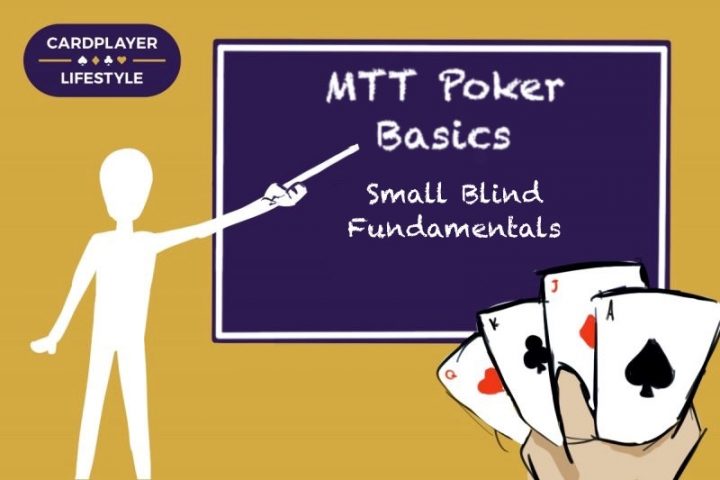Ed. note: This is the third in a series of articles designed to help recreational tournament poker players build their hobby into a profitable endeavor.
Poker is a game all about positions and advantages. To be successful, you always need to be asking “What hands would they raise from that position?” Once you have that part nailed down, you have to get serious about understanding how those hands interact with the flop. And trickiest of all, you must balance your own range by playing aggressively with both your made hands and uncomfortable bluffs.
In the second MTT Poker Basics article, I took a closer look at the best position at any tournament table: opening the button vs. the big blind. But if the button’s perpetual position on opponents sits you in the king’s throne at the poker table, playing from the small blind may make you feel like the court jester. Playing from the small blind ensures that you will always act first postflop and puts you out of position to any other player in the pot. This is such a disadvantage that your overall goal is simply to lose less from the small blind.
Thankfully, there are key fundamentals you can learn to minimize these losses. To counter your positional disadvantage, you will need to retaliate by getting comfortable with the uncomfortable. Let’s dive in.

3-betting preflop aggressively
When you face an open from players in early to mid position, a 3-bet is always going to be a higher frequency play from the small blind than it would be from other positions.
One common mistake is defending the small blind similarly to defending the big blind. You already have money in the middle, so you’re getting a better price than most, right? While that is technically true, it ignores a key factor. Small blind can simply call, but this allows the big blind to squeeze the pot behind us and force us to fold solid hands. Big blind is only incentivized to flat call so many hands because it can certainly close the action preflop.
As a result, many solid looking hands are going to become 3-bets, ideally taking down the pot uncontested. Hands that look appealing to flat and see a flop are often the ones being overlooked. For example, let’s say that you have 80bb and look down at KTs in the small blind. The lowjack has raised and it has folded to you. This is a perfect hand to 3-bet for two reasons.
First, 3-betting KTs can get better hands to fold. Enough of the lowjack’s Ax hands have to go in the muck here, not to mention hands that dominate yours like ATo and KJo. Secondly, you have plenty of equity when you are called by hands like AQo, AJs, and middling pocket pairs. Applying pressure with a small continuation bet often can win you these larger pots without much friction.
For that reason, at 80bb, you can 3-bet any suited broadway combo vs. a middle position open at a fairly high frequency. Even vs. a raise from under the gun, QJs+ is going to prefer 3-betting more than half the time.
For a full breakdown of these frequencies across multiple stack depths, I highly recommend creating a free account on gtowizard.com. The Study tab offers preflop charts from 100bb and below, and you may be shocked to see how aggressive small blind is in many cases. This feature is one of the best free poker resources on the internet, and an absolute must have if you intend to take poker tournaments seriously.
If you’re looking for something a little more comprehensive than a free tool like GTO Wizard can offer, then RangeTrainerPro might be up your alley.
Developing a leading range
The ‘donk lead’ doesn’t sound appealing. Named after the worst players for a traditionally terrible strategy, donk leading certainly doesn’t come naturally these days. But as game theory within poker has advanced, solvers have found that there are certain boards that you can lead from as small blind out of position.
Sticking with 80bb, let’s take a look at an under the gun raise and flat from the small blind. Make no mistake, in general we will be checking the vast majority of flops. Raising under the gun, our opponent has an uncapped range that contains the best pocket pairs, suited broadway hands, etc. But when the flop brings sequential low cards, without a flush draw, the small blind leading range starts to explode.
For example, take a flop like 654 rainbow. On this flop, we can lead into the under the gun raiser nearly 60% of the time. The reason being that our range contains 87s for the nut straight and sets like 55 and 44 at a much higher frequency than the early position raiser. There isn’t a single hand that doesn’t lead these flops at some frequency because we force early position into a difficult position with hands like KJo, JTs, etc. While they may have the overall range advantage, small blind has the nut advantage on these boards, and we can start leaning on our opponent’s disadvantage immediately.
It’s important to note that this flop strategy is tied to rainbow configurations specifically. When there is a flush draw, we check from the small blind pure because an early position raise is almost entirely made of suited hands and pocket pairs. While it may not always be the most natural bluff to make on rainbow boards, having this trick up your sleeve is sure to put early position raisers in the blender quickly.
Finding your floats and check-raises
Finally, this is the area where the majority of players lose the most. Flatting with medium strength hands and folding to flop continuation bets is a recipe for losing way more than 50bb per 100 hands from the small blind. The dirty secret of playing from this position is that if you are willing to voluntarily put money in the pot preflop, you have to be willing to continue past the flop with some uncomfortable holdings, including light floats and check-raises.
Take a flop like Q85 rainbow, for example. Relatively dry flop, no flush draws and low connectivity for straights. The early position raiser is going to have a nut advantage, as we never have QQ without 3-betting preflop. With that in mind, we are certainly going to check any holding we have to the early position in this case. Typically, our opponent should be betting 33% of the pot, with room for larger 66% bet sizes as well.
Too often, players fold here. Of course, most players find their natural continues. Pocket pairs above 55 should always be here, any pair to the board shouldn’t have a second thought. But nearly half the time, we are going to have Ace high or worse facing this action. Generally, we should only be folding about 33% of our range here, floating with 50% of our hands and check raising with around 17%! This is where things get scary for most.
We do have clear check raises for value in our range, namely the sets of 55 and 88. But strap in, because it is time to start blasting with those backdoor draws. At this point, we are going to have many hands that are forced to either fold or check raise.
One example I love is K7s. If this suited combination has a backdoor flush draw on this rainbow flop, it is only folding half the time and check raising with its overcard and backdoor straight draw as well. These are the kind of bluffs that aim to generate folds or find beautiful turn cards like the 6 of your suit, adding tons of equity to your bluff. Hands with more immediate equity like J9s can balance their action between calling and check raising because they will make a strong hand on more turns, already having a gutshot straight draw. In general, if you have any decent amount of equity on the flop, you should rarely fold to a small bet.
For more similar examples, I highly recommend this PokerCoaching.com video with Jonathan Little and Justin Saliba. Saliba has been a rising star in the high stakes tournament community over the last three years, and his instruction on this spot is freely available on YouTube below.
Losing less in a difficult spot
No, playing from the small blind is never going to be easy.
Even with these fundamentals in mind, you will still face tough decisions and occasionally feel lost. But remember: you are always going to be losing money from the small blind. It is nearly impossible to beat when you are forced to pay half a big blind in the worst position at the table. So our goal is simply to make the most of an impossible situation.
If you take anything away from this poker strategy article, remember that when you face a raise in the small blind, don’t bring a knife to a gun fight. Be ready to go to war and stay poised with your most uncomfortable holdings, because check-folding them is even worse than folding those solid hands preflop. With just a little fight and intuition, you can start putting opponents in tougher spots yourself and decrease your losses substantially.






